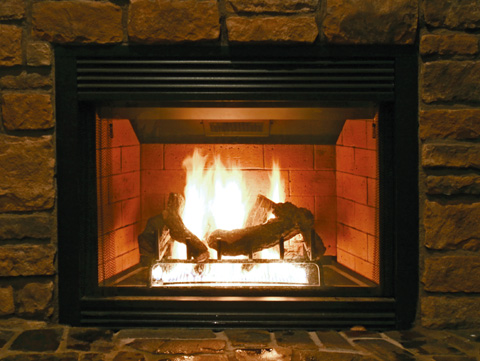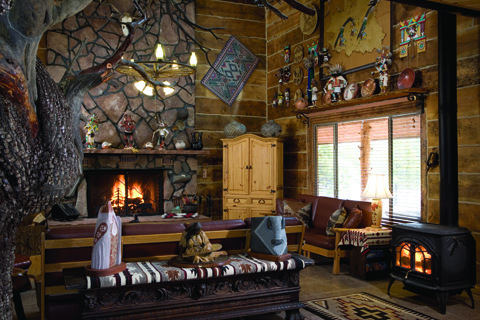Log homes and fireplaces go together like horses and carriages, to misquote a vintage song. More often than not, the fireplace is the focal point of the home and the primary gathering spot for family and friends. There’s nothing better than sitting in front of a crackling fire and inhaling that wonderful wood smoke.
While you are enjoying the warmth and beauty of the fire, the heat in the rest of your home is being sucked up the chimney along with your hard-earned dollars. And that lovely, smoky aroma may be damaging your health. By the very nature of its construction, a traditional masonry fireplace is designed to take oxygen from the surrounding area to keep the fire burning. Not only does the fireplace extract warm air from the other rooms in the house, it draws in cold air from leaks around windows and doors, wall cracks, and attic space. Even when there is no fire going, the chimney siphons warm air from the house and carries it up the chimney. In summer months, cooled indoor air escapes up the chimney.
Most homeowners choose a masonry fireplace for its appearance and the ambience it creates; it is not intended to heat the entire home. At best, when the fire is kept at a high temperature, its energy efficiency ranges between 20 to 30 percent—when the difference between the indoor and outdoor temperature is 40 degrees and there is a moderate wind. When the fire starts to die down, the efficiency drops to 10 percent or less, meaning that of the heat generated by the fire while it is cooling down, only 10 percent goes toward heating the room and the rest goes up the chimney.

Honka Log Homes/photo by Roger Wade
There are also health concerns attached to having an open fire in your home. Smoke may smell good, but it’s made up of a combination of gases and fine particles that are produced when wood burns, especially during inefficient combustion. Carbon monoxide, sulfur oxides, methane, nitrous oxide, and particulate matter (PM) are products of wood burning. Most of the wood’s fuel carbon is converted to carbon dioxide when it is burned. But, if there is inefficient combustion, a low combustion temperature, and a great deal of excess air, more carbon monoxide than carbon dioxide is produced. Methane emissions are greater during incomplete or low-temperature combustion; both nitrous oxide and volatile organic compounds (VOCs) may also result. Creosote is another component of wood smoke. It is a tar-like substance that burns off in a hot fire, but at lower temperatures it sticks to the fireplace surfaces—the flue and the inside of the chimney—which creates a fire hazard.
The fine particles in the smoke can get into your eyes and respiratory system, causing burning eyes, a runny nose, or bronchitis. Long-term exposure to the particles may cause such problems as reduced lung function or chronic bronchitis. People with asthma or allergies are very susceptible to the effects of inhaling smoke. Those with pulmonary disease, emphysema, congestive heart failure, or angina may experience health problems at lower smoke levels or after minimal exposure. Children are also more susceptible because their respiratory systems are still developing.
There are a number of things you can do to increase the efficiency of your fireplace:
1. Isolate the room where the fireplace is located by closing doors to other parts of the home. If this isn’t possible, turn the thermostat down to 55 degrees while you are enjoying the fire. (Make sure that everyone living in the home is gathered around the fire. Lowered temperatures may cause health problems for the aged, young children, and those who have respiratory or circulatory diseases.)
2. Install tight-fitting glass doors. This will improve efficiency by controlling the flow of preheated room air into the fireplace. Leave the doors open while the fire is burning hot and efficiency is optimum; as the fire starts to die down, close the doors to reduce the draft and heat loss throughout the house. Glass doors will not prevent air from being pulled into the home, but they will reduce air loss by up to 50 percent. The doors allow heat to radiate into the room, and they prevent sparks from jumping out of the fireplace.
3. Install an outdoor air intake on the back or side of the fireplace. A small section of pipe draws outside air into the fireplace to aid in combustion, thus reducing the amount of warm air taken from indoors. This reduces heat loss while the fire is burning hot and while it is cooling down.
 4. Install a fireplace insert. Fireplace inserts work much like wood-burning stoves, with stricter air control to regulate burning. The inserts draw less air from indoors and do not need outside air intakes. Inserts come in a variety of sizes and have tight-fitting glass doors. There is an air space around the firebox that acts as a heat chamber; heat that would otherwise go up the chimney is dispersed around the top, sides, and back of the unit and is blown into the home by a small fan.
4. Install a fireplace insert. Fireplace inserts work much like wood-burning stoves, with stricter air control to regulate burning. The inserts draw less air from indoors and do not need outside air intakes. Inserts come in a variety of sizes and have tight-fitting glass doors. There is an air space around the firebox that acts as a heat chamber; heat that would otherwise go up the chimney is dispersed around the top, sides, and back of the unit and is blown into the home by a small fan.
There are wood-burning alternatives to a fireplace that will heat your home more efficiently and burn cleanly. One is the wood-burning stove. Wood stoves have been around for a very long time and are growing in popularity once again. Thanks to the EPA’s Clean-Burning Wood Stoves and Fireplaces Program, today’s approved wood-burning stoves have greater efficiency and safety. An older, uncertified stove released 15 to 30 grams of smoke per hour, but the newer approved models produce almost no smoke, little ash, and only 2 to 7 grams of smoke per hour. Wood stoves can serve as cost-effective heating systems in the winter and they keep your home warm in the event of a power outage.
Wood-burning stoves are available in several materials, styles, and colors. A cast iron or porcelain stove may resemble antique, pot-bellied stoves or sleeker, more modern stoves. Soapstone is also a popular material; its soft color and finish blend beautifully with a log home.
A small wood stove is ideal for heating a family room or small, seasonal cottage. Or a small stove can be used for zone heating. A medium stove will heat a small house or a medium-sized, energy-efficient house. The largest stoves work well in bigger, open-plan houses, especially in colder climates. To select the right stove for your home, consult with a reliable retailer; bring the floorplan for your new home along to help the expert advise you on stove size and location. Look for the white EPA label on the back of the stove for the best green options.
There are two types of wood-burning stoves: noncatalytic and catalytic. While most stoves on the market today are noncatalytic, some of the high-end stoves use catalytic combustion. Catalytic stoves are a bit more complicated to operate and they require proper maintenance to operate at peak performance.
Noncatalytic stoves have firebox insulation, a larger baffle that allows a longer, hotter gas flow path, and preheated combustion air that is introduced through small holes above the wood in the firebox. The baffle and some of the other parts may need replacement over time due to the high heat of effective combustion. In a catalytic stove, the smoke exhaust goes through a coated ceramic honeycomb where the gases and particles ignite and burn. The honeycomb catalyst will degrade over time and need to be replaced; its longevity depends on the owner’s ability to maintain the stove and use it correctly.

Another alternative to the fireplace is a pellet stove. These stoves look and operate like traditional wood-burning stoves, with a glass-enclosed burn chamber. The pellets are made from compressed sawdust with no additives and cost less than propane, electricity, or natural gas. The sawdust byproducts used to be destined for the dump, but now make up a smokeless fuel for wood stoves.
The pellets are stored in a hopper and then fed into the stove by a system of augers. This system allows the stove to operate autonomously for hours, days, or weeks, depending on the size and fuel requirements of the stove. Most of pellet stoves need electricity to operate the augers and loading mechanism; battery packs are available to use in the event of a power outage. You can even heat domestic hot water with some models. Pellets can be purchased in 50-pound bags or by the ton. The fuel supply for one winter season will take up the space found in a single-car garage. A pellet stove is easily installed and maintained. All you have to do is fill the hopper, empty the ash pans once a week, and clean the entire stove periodically. Most retailers recommend that you have the stove serviced once a year.
Wood is a renewable resource in most of North America. Burning it does not add additional carbon dioxide to the environment because it is plant based. Only the carbon dioxide the tree absorbed while it was growing is released when it burns. If trees were felled at your building site, consider having them cut for firewood. Or, contact local tree cutters and ask if they will deliver cut wood that would otherwise be carted to a landfill or dump to you. You will save money and reduce landfill dumping at the same time.

